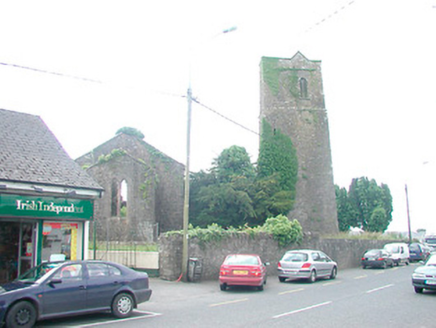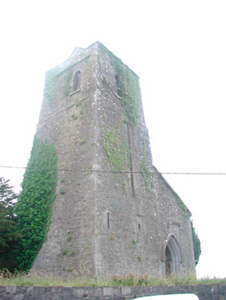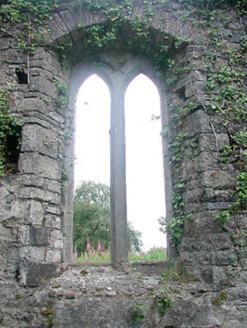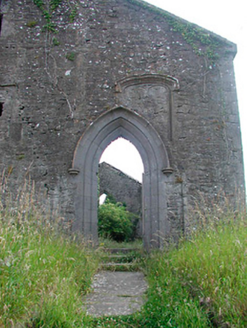Survey Data
Reg No
15308008
Rating
National
Categories of Special Interest
Archaeological, Architectural, Artistic, Historical, Social
Original Use
Church/chapel
Historical Use
Church/chapel
Date
1550 - 1870
Coordinates
260017, 262666
Date Recorded
05/07/2004
Date Updated
--/--/--
Description
Freestanding former Church of Ireland church, rebuilt c.1810 incorporating fabric of later medieval church building (c.1550). Comprises two-stage fortified medieval belfry tower on square plan (c.1550), a Board of First fruits-type hall (c.1810) and a later nineteenth century transept (c.1860). Now a roofless ruin. Constructed of limestone rubble with moulded stone detailing. Later transept constructed of snecked limestone with moulded stone dressings. Pointed-arch window openings with moulded stone surrounds and remains of timber and stone tracery to hall and transept. Pointed-arched louvered openings to belfry and loop hole openings below to adjoining tower. Main entrance to west with pointed-arched opening, moulded stone surrounds and hoodmoulding over. Set back from road in own grounds with graveyard to site. Rubble limestone boundary wall with wrought-iron gates to street frontage.
Appraisal
An imposing and historically important church of three distinct phases. It is well constructed, despite its ruinous condition and has many interesting architectural details, including the stone staircase to the tower. The cut stone dressings through the church are the work of skilled masons. The contrast between the rubble limestone construction of medieval tower and the snecked limestone of the later transept creates an interesting façade and gives an insight into changing architectural fashions through time. This structure is of archaeological significance due to the presence of pre-1700 fabric. The later transept was built to designs by Joseph Welland c. 1860. Welland was a noted ecclesiastical architect of his day and was responsible for all Church of Ireland church building projects in Ireland from 1843 until he retired in 1875. Welland was responsible for newly constructed churches at Collinstown and Athlone, and converted the late medieval fortified church at Taghmon (north of Mullingar) for use as a Church of Ireland church in 1843, which is an interesting parallel with this church at Delvin. This structure and associated graveyard forms a attractive feature and landmark on the main approach road into Delvin from the south.







